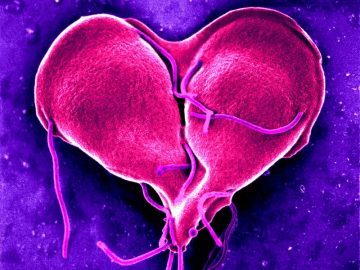Jon Kelvey in Smithsonian:
 Why organisms began having sex, rather than simply reproducing asexually as life did for billions of years—and still does, in the case of single-celled organisms and some plants and fungi—is a bit of a mystery. Sexual reproduction evolved around a billion years ago or more, despite the additional energy required and the seeming hinderance of needing to find a suitable mate. Prevailing theories hold that sex became the dominant form of reproduction due to the benefits of greater genetic diversity, allowing offspring to adapt to changing environments and keeping species one step ahead of parasites that evolved to plague the parents.
Why organisms began having sex, rather than simply reproducing asexually as life did for billions of years—and still does, in the case of single-celled organisms and some plants and fungi—is a bit of a mystery. Sexual reproduction evolved around a billion years ago or more, despite the additional energy required and the seeming hinderance of needing to find a suitable mate. Prevailing theories hold that sex became the dominant form of reproduction due to the benefits of greater genetic diversity, allowing offspring to adapt to changing environments and keeping species one step ahead of parasites that evolved to plague the parents.
But in a new paper in PLOS Biology, a team of scientists led by the University of Montpellier in France and Deakin University in Australia suggest another reason life started and kept having sex: the threat of transmissible, cancerous freeloaders. “We suggest that sexual reproduction evolves to prevent invasion by transmissible selfish neoplastic cheater cells, henceforth referred to as transmissible cancer cells,” Frederic Thomas, an evolutionary biologist at the University of Montpellier and lead author of the study, says in an email. “To our knowledge, this selective scenario for the initial evolution of sex across the tree of life is novel.”
Cancer wasn’t a problem for the earliest life forms, prokaryotes, or single-celled organisms that lack a cell nucleus, such as bacteria and archaea. These creatures reproduce asexually, making a copy of their singular chromosome and essentially cloning themselves. But things changed with the evolution of eukaryotes more than 2.5 billion years ago. These organisms contain central nuclei encompassing their genomes in a set of chromosomes. Groups of eukaryotes joined together to form the first multicellular organisms—the predecessors of all complex life on Earth, from plants to insects and reptiles to mammals. When these organisms reproduce, genetic material is contributed from two mates, creating genetically unique offspring.
More here.
